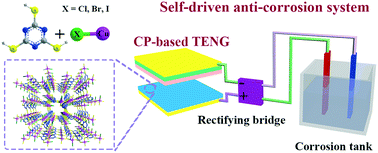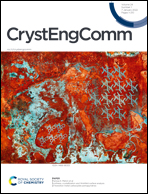A facile method to enhance the output performance of triboelectric nanogenerators based on coordination polymers by modulating terminal coordination groups†
Abstract
The output performance of triboelectric nanogenerators (TENGs) basically depends on the inherent nature of friction electrode materials. In this work, a series of isostructural Cu(I)-CPs (coordination polymers) with different terminal coordination groups from the same main group, formulated as [Cu(μ3-H3ttc)X]n (1: X = Cl, 2: X = Br and 3: X = I; H3ttc = trithiocyanuric acid), were chosen as the friction electrode materials to fabricate TENGs (Cl-, Br- and I-TENG based on compounds 1–3, respectively) to clearly clarify the influence of chemical microcomposition on the output performance of TENGs. The results indicated that the polarity of the compounds determined from dielectric constants was greatly affected by the halogen elements, which plays a decisive role in the output performance of the TENGs. I-TENG based on the Cu(I)-CP containing the least electronegative halogen atoms but with the largest polarity had the largest output performance, followed by Br- and Cl-TENG. As a practical application, I-TENG was used as a power source to construct a self-powered anticorrosion system to protect metal materials from corrosion.



 Please wait while we load your content...
Please wait while we load your content...